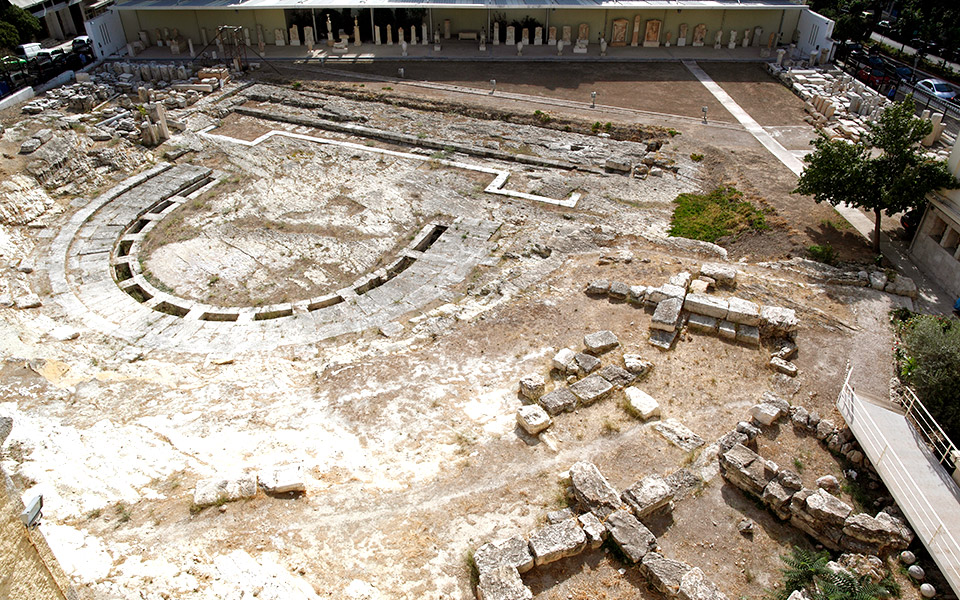In a move that even stripped of its political and commercial import was widely seen as unprecedented, Greece’s Central Archaeological Council, in April of 2019, declared the entire section of the city of Piraeus that lies within the bounds of its ancient walls to be an archaeological site.
Some eight excavations undertaken in conjunction with the expansion of Athens’ Metro Line 3 and the tramway extension to Piraeus are indeed raising the profile of the mighty port city, but when you consider the historical gravitas here—Piraeus was the naval base of ancient Athens—the upgrade in archaeological status can be seen less as a shocker than belated act of recognition.
The Piraeus peninsula is one of the planet’s most remarkable archaeological palimpsests, a place not only defined by the indentations of the Mediterranean but historically powered by it too, and home to a generally obscure checkerboard of ruins by turns puzzling and messy, and downright ethereal. Though the pocket ruins that pepper Piraeus may lack Instagram appeal, all you need is some imagination and maybe a map to conjure the way things were a long time ago in chapters of Greek antiquity very far away.
Traces of once mighty walls, broken columns and other remnants push through the Piraeus soil—at least, in those patches of the densely populated peninsula where the modern polykatoikies (apartment blocks) have been kept at bay—like plates of a stegosaurus piercing the largely indifferent urban skin. Some ancient sites did, of course, lose out to modern construction: the Dionysian theater that once stood at the base of the hill of Kastella, behind the small Microlimano Harbor, is one such example. But there are plenty of smaller ones preserved largely by dint of benign neglect, basking in an obscurity that only adds to their appeal.
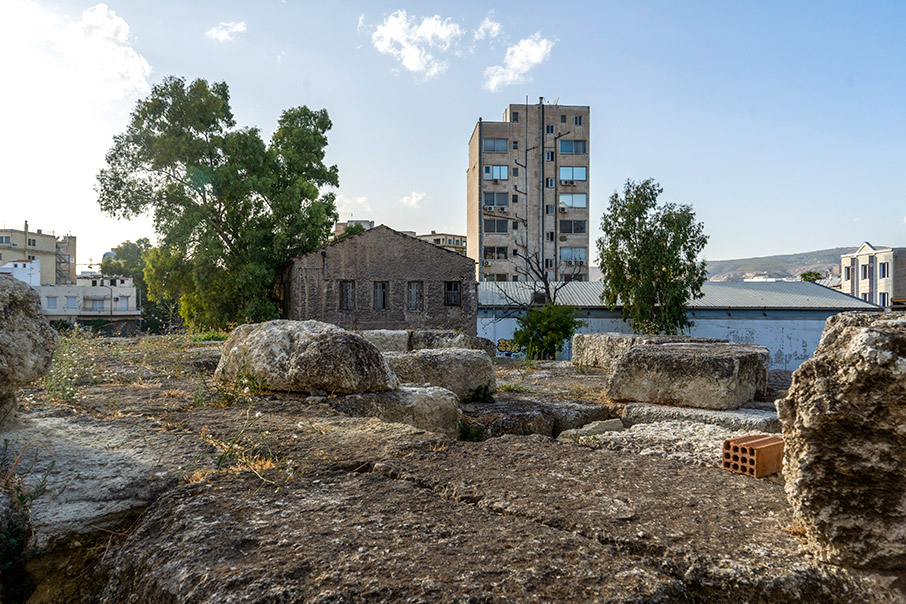
© Perikles Merakos
Then, unseen, is the secret city that lies below: “We have identified more than 700 cisterns, wells and tunnels, mostly from the fourth and third centuries [BC], and that were reused for houses in the Roman period,” says George Peppas, an archaeologist with the Ephorate of Antiquities of West Attica, Piraeus and the Islands who knows the topography of Piraeus inside out. “Piraeus is like Athens and Thessaloniki,” he says. “In all three, there is a city beneath a city, going back 2,000 years and even longer.”
While the current transportation construction works might have spurred greater scrutiny of the subterranean city, archaeologists have long known it was there. Some of the most noted finds, such as the dreamy bronze statues of Athena and Apollo that now hold court in the Piraeus Archaeological Museum, were unearthed by construction workers in 1959.
And for that you can probably thank the certifiably diabolical ancient Roman dictator Sulla, responsible for razing much of Piraeus during his siege of Athens in 87-86 BC. What residents weren’t killed or enslaved during that orgy of violence tossed whatever they could find down wells or into cisterns so the Romans couldn’t get their hands on their belongings. Fragments of pottery, household objects and statues—some even made of unusual materials like bronze or wood—turn up stealthily in these parts, but also regularly. The riches of Piraeus may not have the shimmer of gold, but they are varied and vast.
With few exceptions, the visitor encounters ruins in Piraeus much differently than he or she does in Athens proper. “The ancient sources are less accurate when it comes to Piraeus,” Peppas says. “When Iakovos Dragatsis became the first archaeologist to excavate in Piraeus [at the end of the 19th century], it wasn’t like with Athens where you can read Pausanias and Strabo who reference the various monuments and it’s mostly very clear where things are. It is still complex in Athens, but it’s easier to connect the dots.
“Here in Piraeus we have less information and what we do have is less accurate. Like for the ancient agora and the Temple of Zeus Soter, there are opposing views as to the exact locations and neither has been found: the temple especially is like the white rabbit of archaeologists in Piraeus—everyone’s looking for it.”
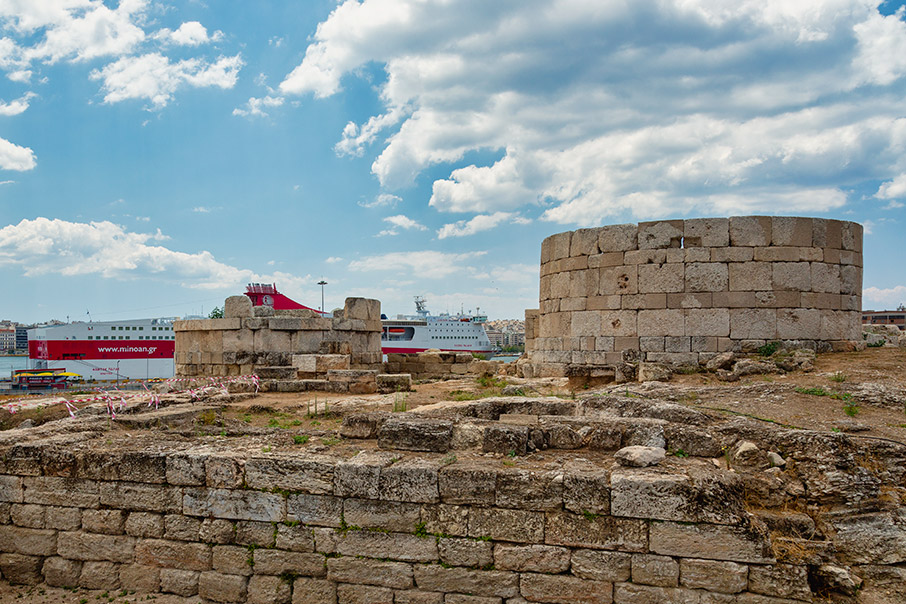
© Perikles Merakos
Ironically, though the archaeological canvas of Piraeus does look a lot more scattershot than, say, that of Athens or Rome, and iconic monuments are obviously lacking, there is lots more for the modern Indiana Jones to sink his teeth into than you might think.
The reason for this goes back to the very inception of the city. The Athenians needed to build a fortified naval base that could contain the three ports on the peninsula: Kantharos, the main harbor where now the cruise ships and ferries call in, but also the two smaller ones, Zea and Mounichia (the latter now called Mikrolimano, and both today used principally for yachts and pleasure craft).
The Long Walls had already created a fortified road between Athens and the Piraeus peninsula. Long before that, Athens had grown from an ancient settlement in the Archaic period into a city, but only haphazardly. Piraeus was going to be something new, deliberate and, above all, planned. And there had to be houses for the traders, facilities for the guys who manned the triremes and warehouses for the ships, too (the neosokoi), traces of which you can still see today (see below).
Enter Hippodamus, an urban planner and (yes) meteorologist based in Miletus, on the Aegean coast of what is today Turkey. Renowned as an architect and civic planner, he was a man in demand, and so the Athenians called on him for his services—that was in the 440s BC, just a few decades after the epic Battle of Salamis in which the Athenians delivered an improbable but decisive blow to the Persian fleet of King Xerxes.
After that, Piraeus would become prime real estate, but a fortified harbor was just the start. “With Hippodamus, you didn’t have just one person designing everything like the starchitects of today,” says archaeologist Peppas. “He was part of a committee because you have to remember this was during the period of radical democracy in Athens—there is never just one person to decide.
“So they decided to plan this new city according to Hippodamus’ ideas. They designed the main road and connected it with the two main gates and, according to the Hippodamian plan, the roads formed a cross that connected at the city center. The public spaces and the agora, the residential neighborhoods, were decided next.”
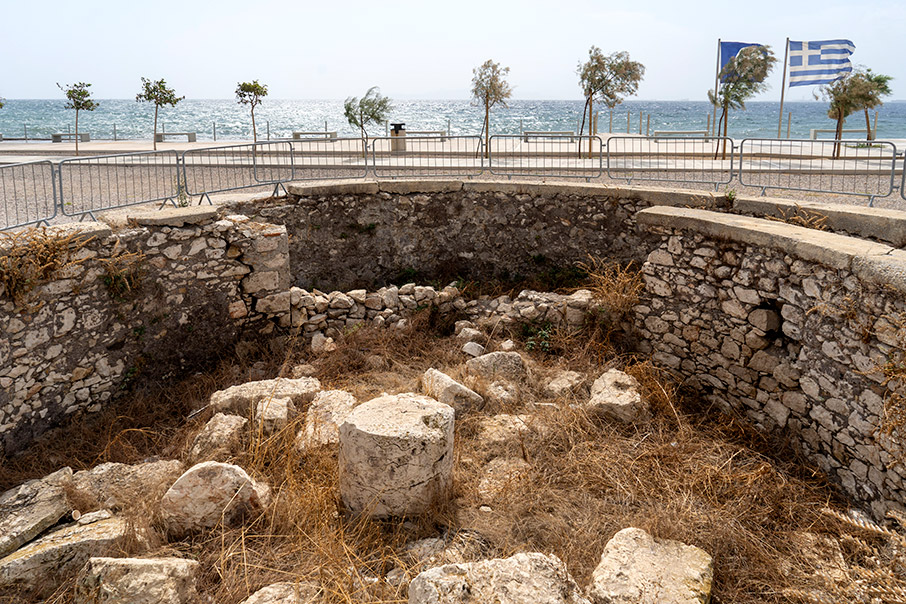
© Perikles Merakos
Back then, they built things in stone and they were designed to last. The destruction by Sulla that would come notwithstanding, and despite the piling on of the centuries, the foundations of the ancient classical phase of Piraeus haven’t gone anywhere.
“What we learned from the recent tram excavations are that we zeroed in more specifically on exact locations of roads and sites from the Hippodamian plan period. We have another archaeologist who is making a GIS map of all the plots excavated in Piraeus. We can draw them and feed that into the map in absolute coordinates, meaning that we clearly see the outlines of the classical city.”
In Piraeus as elsewhere, technology may make things easier for archaeologists and experts, but happily it does little to make inroads on the aura of enchantment that the city’s stone ghosts, in the aggregate and individually, still exude.
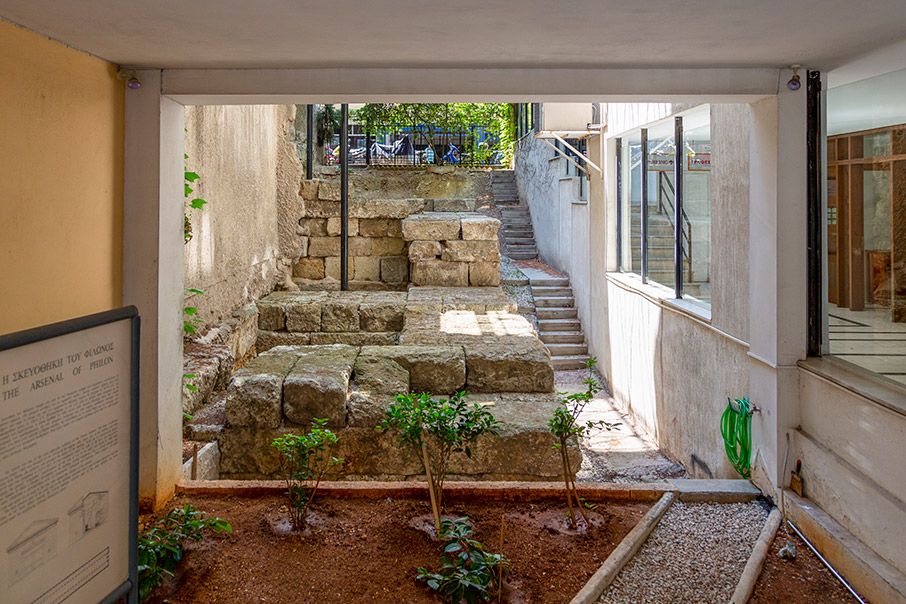
© Perikles Merakos
A curator at the J. Paul Getty Museum in California once told me that “Ruins evoke a contrast between what is lost and what is retained, between civilization and nature, and there is something quite poetic about them in that sense.”
You may not register the poetry of the stones as you’re running to catch your island ferry, but you can preempt that oversight by noting the following locations of pocket ruins that, in their subtle but resolute way, help make Piraeus what it is today: a mythic place that marries the maritime and the mysterious with an easy grace and, I would add, a tantalizingly Greek aplomb.
A GUIDE TO THE RUINS OF PIRAEUS
The Zea Shipsheds
When Piraeus served as the base for the Athenian fleet, there were hundreds of ship sheds (neosoikoi in Greek) lining the harbors of Mounichia (Mickolimano) and Zea. These impressive sheds were built of stone, 50m long and up to 8m tall, and berthed the famous trireme ships that plied the seas in times of war. The best surviving dockyard ruins are those at the edge of the circular Zea harbor (also called Pasalimani), but they are today tucked under modern apartment blocks, the water line having changed over time.
Find it: Akti Moutsopoulou, facing the harbor, between Thrasivoulou and Siraggeiou streets. Look for the explanatory panels in front of the apartment buildings
Arsenal of Philon
Visitors to the Epigraphical Museum of Athens will get a hint of the historical import of the now-very-hidden Skeuotheke, or Arsenal of Philon, because the museum houses an inscribed marble stele with detailed technical instructions for its construction. The Arsenal was essentially a storehouse for the equipment (oars, masts and such) needed to outfit 134 ships of the Athenian fleet. Excavations in 1988-89 revealed that it was an oblong rectangular building with a pediment, a Doric frieze and wooden roof and two doors at its two narrow sides. The structure was deliberately large to make room for the presumed future needs of the Athenian military port which was the raison d’etre of Piraeus. The ruins are run over with vines and next to a parking ramp.
Find it: at 170 Ipsilantou Street, located within the Piraeus Land Registry building.
Alphitopolis Stoa
It’s fenced off and you can barely see it, but the location is so prominent it’s like a jewel hidden in plain sight: the long Alphitopolis Stoa is where the wheat and barley flour supply for Piraeus and Athens was stored during the time of Pericles—the Golden Age of classical Athens. Peer through the tattered fencing to see the stone foundations peeping through the unruly grass. Ancient grains indeed!
Find it: Corner of Akti Posidonos and Dim. Gounari, across from the main harbor
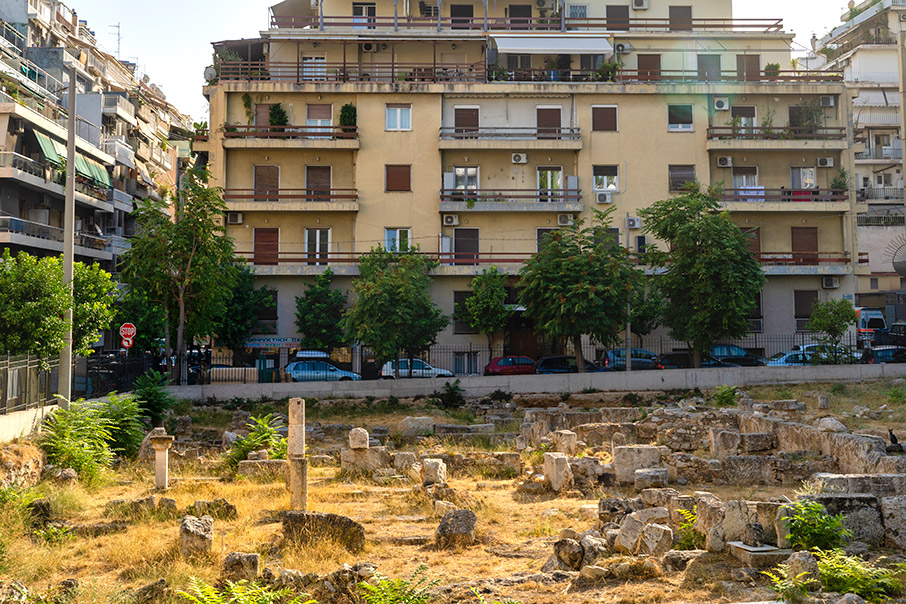
© Perikles Merakos
Hellenistic Theater of Zea
This ancient theater was modeled after the theater of Dionysus beneath the Acropolis, and was built in the second century B.C. from rock that came from the Piraeus peninsula. You can discern not only the foundations of the stage but also the backstage with orchestra and some of the galleries.
Find it: On the grounds of the Piraeus Archaeological Museum
City Gates I (Asty Gate)
This is the vital ancient entry point to Piraeus that you’re going to miss if you only see the port side of town. The ancient city gates, now in ruins, were at the terminus of two ancient roads that connected Athens with the fortified harbor—one road was between the Long Walls but the other (and even older) one was outside them, ending here at the Asty Gate. These were part of fortifications ordered by Themistocles but completed by Pericles. The modern, hangar-like structure at the southern perimeter of the fenced-off site houses finds from the recent excavations undertaken alongside construction for the extension of the Piraeus metro and tram lines.
Find it: Corner of 34th Sintagmatos Pezikou and Pilis streets
City Gates II (Eetionian Gate)
On the north side of the main Kantharos harbor, where the large ferries from Crete arrive, there is a hillside essentially plastered over with ancient walls and gates—more than pocket-sized to be sure, but still fairly obscure. There are ruins of walls from both the Cononian and Themistoclean phases of Athens and Piraeus history (and more apocryphally, ruins of the Long Walls), but the rounded stone lookout towers (remnants of the Eetionian Gate) probably date from the later Hellenistic period.
Find it: On the hill across from Port Gate E2 (but the entrance is on Kanari street; a taxi is advised)
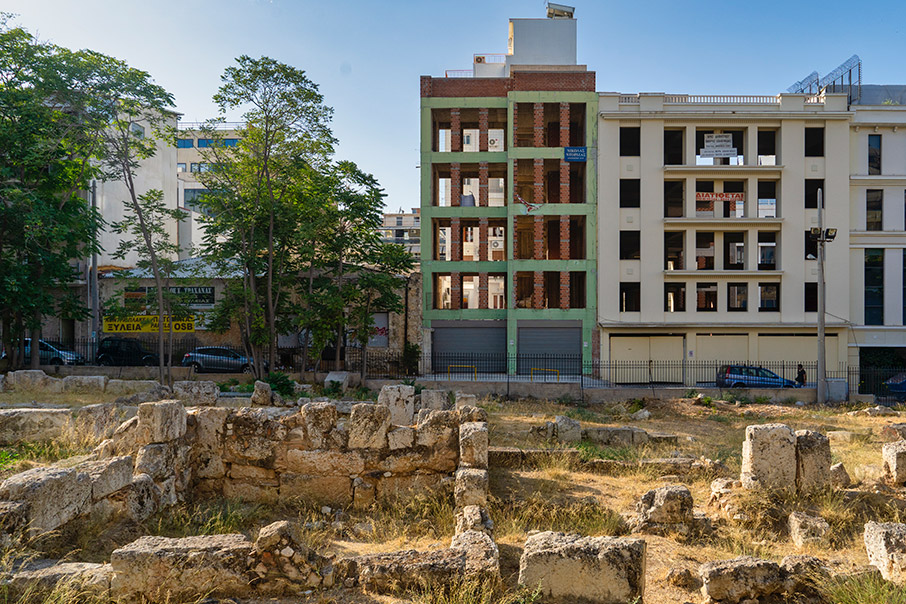
© Perikles Merakos
Rondiri Square
The archaeological site of Rondiri Square is basically a chunk of Piraeus from the Roman era that came to light during the construction of the Piraeus Courthouse in 1980. The ruins that are visible today (but only from the sidewalk, as the site is completely fenced off) are built over foundations that were laid out as part of the original Hippodamian plan for the organization of Piraeus during the Late Classical period.
Find it: Corner of Skouze and Iroon Politechniou streets
Terpsithea Square
Actually, this evocative site is located adjacent to Terpsithea Square, at the southwest corner. In a nutshell, what came to light in excavations mainly in the late 1990s was another entire ancient city block, with sections of classical Greek neighborhoods (synoikies) from the Hippodamus era clearly discernible as well as ruins of a later urban Roman villa. Coins from the fifth to fourth centuries BC were found as well as clay figurines of Eros, votive naiskoi of Kybele and marble statuettes of Aphrodite. This section of the square is encircled by a gate, but you can still get a good glimpse of the numerous stone pillars and fragments of ancient house walls.
Find it: Corner of Skouze and Perikleous streets
Tomb of Themistocles
The first thing to know about the tomb of Themistocles is that it may not be the actual tomb of Themistocles, the great general whose idea it was to build up the Athenian fleet and who led Athens to victory over the Persians at the Battle of Salamis. For many years, the rounded stone ruins that are said to have housed his tomb were hidden on the grounds of a private fertilizer factory in the Drapetsona section of Piraeus.
Find it: in Drapetsona, facing the sea

